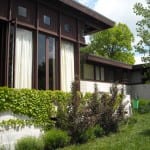We had a wonderful summer evening at the Frank Lloyd Wright Boulter Residence in Clifton, 1 Rawson Woods Circle, 45220 supporting Rozanne.

Please support Roxanne and learn more about Cincinnati’s leading national role in the Urban Renewal movement. From Roxanne’s web site,
“A Strong Cincinnati Is Good for Everyone
Since returning to City Council in 2007, I have focused on initiatives that will build a strong Cincinnati by enhancing the quality of life in our neighborhoods, building a globally-competitive local economy, and responsibly managing city resources.
These efforts include:
• Building Great Neighborhoods – Cincinnati will soon have a new tool to revitalize our neighborhoods using an innovative, community-driven alternative to conventional zoning called form-based codes.
• Making Great Neighborhoods Great Places – Neighborhoods around the city, and cities across the country, are recognizing the need to transform our streets, making access for people, not cars, the priority, and creating destinations instead of raceways through town.
• Building a Transportation System – The current project to redesign the corridor from the Brent Spence Bridge to I-275 will have a profound impact on our city and the region. Council’s Transportation and Infrastructure Subcommittee is working to make sure the project captures the economic development opportunities for the city and the 15 neighborhoods that line the corridor.
• Homeless to Homes – The Homeless to Homes initiative will move Cincinnati’s single homeless men and women from the streets to homes.
Event sponsored by Janet Groeber and Chuck Lohre.
About the Boulter House
Noted American architect Frank Lloyd Wright designed the four-bedroom Boulter House in 1954 near the end of his life.
Completed in 1956, it’s one of four Wright designs in Cincinnati. The Boulter family occupied this “Unsonian” style home (a term Wright coined for his vision of “democratic” well-designed residences — with simplified construction methods — for the country’s growing middle class) for the next 33 years.
A 44-by 18-ft “great room” makes up the first floor and features Wright-designed built-in features, such as a 24-ft long banquette as well his designs for occasional tables, a dining table and other seating. This living area opens to a 40-ft long wall of 10-ft high windows facing south, which also offers the home passive solar heat . The current owners are undertaking a landscape restoration and have already restored the home’s compact “work space,” Wright-speak for the kitchen. A second floor overlooking the first, contains four bedrooms and the three-room bathroom suite.
About Form Based Code from the Glaserworks Architecture and Urban Design website http://www.glaserworks.com/www3/MixedUseStudio/fb-code.html:
“What is Form-Based Code?
A Form Based Code is a combination of a Zoning Code and a set of Subdivision Regulations that enable communities, developers, planners and governments to build neighborhoods of character based on form.
Form Based Codes typically value the form (massing, scale, placement and architectural design) of buildings more than the uses residing within the buildings themselves. The precept of Form Based Codes is that comfortable, high quality public places (e.g. -street corridors, intersections, plazas, parks, etc.) are created by the buildings that form them. Form Based Codes are usually employed to encourage walkable, mixed use development in specified urban or suburban areas.
Communities like Form Based Codes because they require property owners, developers and governments to follow rules in the design and development of each property of an area that will result in the creation of an urbane environment – one where the whole is greater than the sum of its parts. Communities like Form based Codes because they encourage what the community views as preferable development – by both the public and private sector.
Developers like Form Based Codes because they ensure that property they do not control, but that is in the same area, will be designed and developed in a like-minded manner.
Developers like Form Based Codes because they can rely on a predictable, and usually shorter, entitlement process. Developers also like Form Based Codes because they require governments to design and build street corridors to specific standards of urban quality and scale.”
(11-27-19 301 redirect done)
